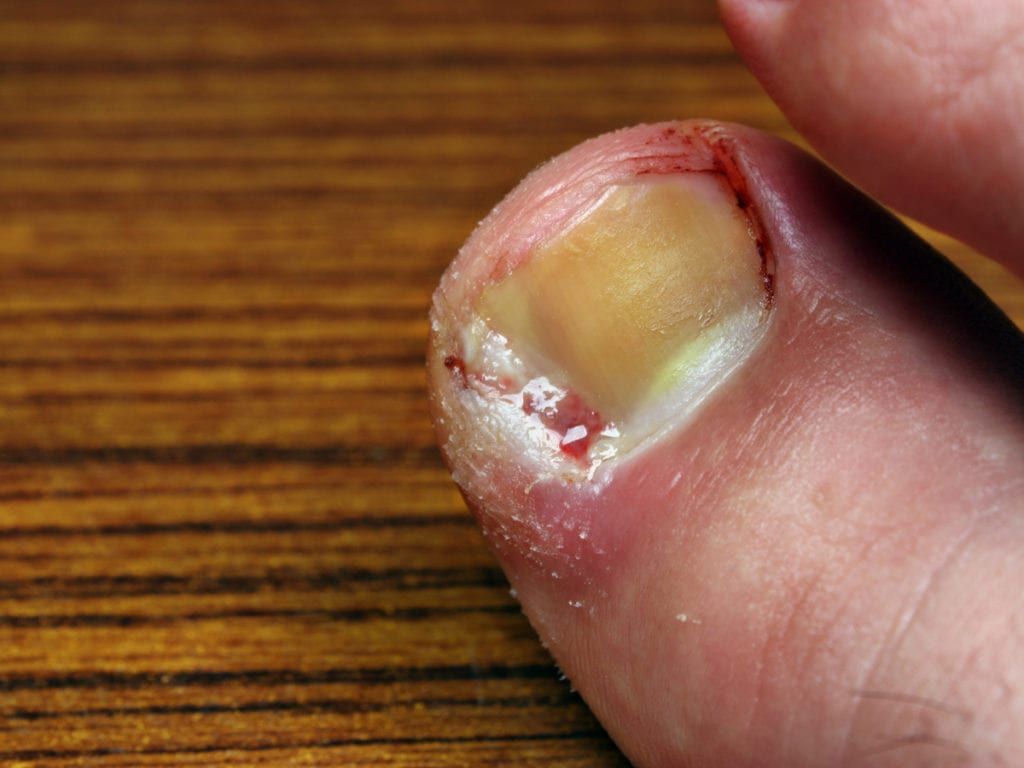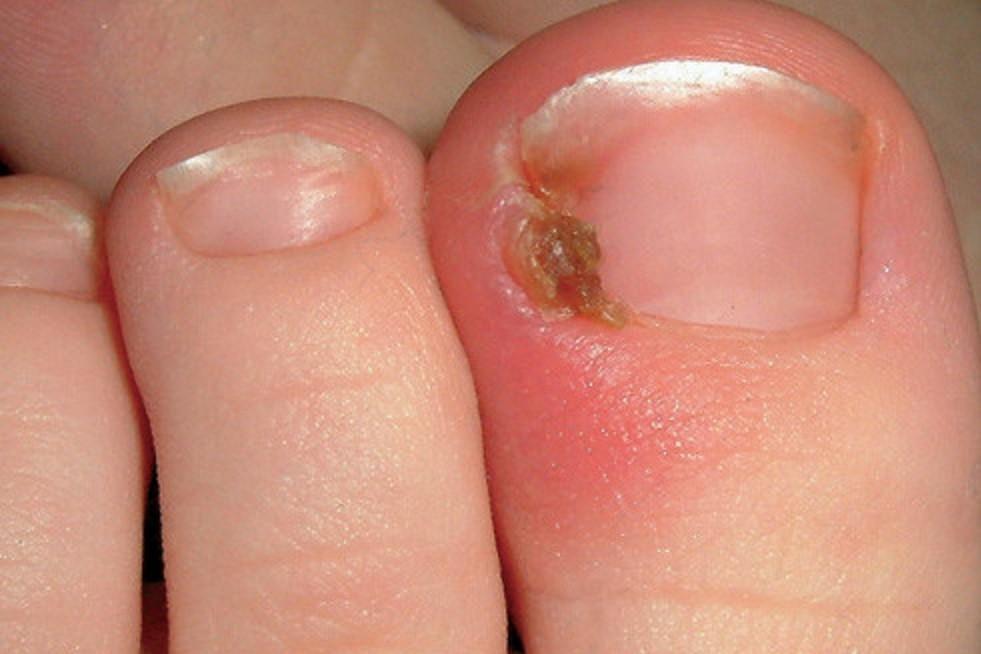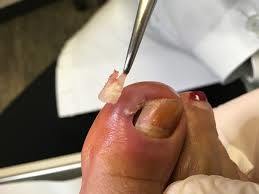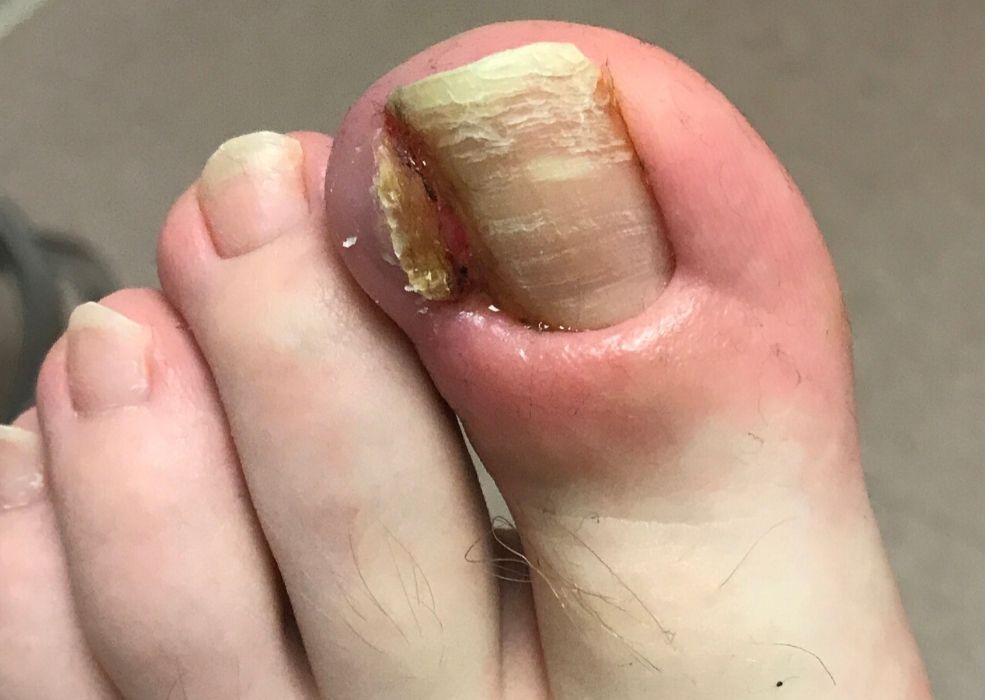An ingrown toenail (onychogryphosis or paronychia) is caused by the pressure from the ingrowth of the nail edge into the skin of the toe. Once the edge of the nail breaks through the skin, it produces inflammation. Initially presenting as a minor discomfort, it may progress into an infection in the adjacent skin (cellulitis) and/or become a reoccurring problem. Ingrown toenails most commonly affect the large (great) toes.
An ingrown toenail can develop in two ways. Sometimes the nail grows into surrounding skin. At other times, the skin grows over the edge of the nail. Ingrown toenails commonly occur as a result of trimming toenails with tapered edges instead of cutting nails straight across. As the nail begins to grow, it may curl under and dig into the skin or the skin may infringe upon the nail. The skin around an ingrown toenail may be red and swollen, causing pain. Severe cases may ooze pus.
What triggers ingrown toenails?
An imbalance between the size of the nail and the enlargement of the nail skin edge causes ingrown toenails. This condition can be exacerbated by improper trimming of the toenail, an inherited or hereditary condition, and improper shoe fitting. Injury by overly aggressive pedicures and nail picking are also common causes.
Some people’s toenails naturally curl inward (known as pincer nails). These toenails can easily become painful. Adolescents and athletes perspire more often. This causes nails and skin to be soft. The thin nail can eventually split and pierce the softened skin.
What causes an infected ingrown toenail?
The warm, moist environment of the feet can be a breeding ground for bacteria and fungi. These commonly include Staphylococcus, Pseudomonas, dermatophytes, Candida, and Trichophyton. When there is a break in the skin from the offending nail border, these organisms can invade the area and cause an infection.
Treatment for these infections is essential to maintain healthy toenails and feet. If not treated, the infected toenail can cause serious problems such as chronic pain and disfigurement, cellulitis, and bone infection.
Are some people more prone to ingrown toenails?
Several risk factors may predispose a person to have an ingrown toenail. The following are some of the more common causes: 
- Athletics, particularly stop-and-start sports such as tennis, soccer, and basketball,
- Improper shoe gear that is either too small or too large,
- Repetitive pressure or trauma to the feet,
- Poor foot hygiene,
- Abnormal gait and poor foot mechanics such as pronation,
- Foot or toe deformities, such as bunions, hammertoes, and flat foot,
- Congenital toenail deformity,
- Abnormally long toes,
- Obesity,
- Diabetes,
- Heart, kidney, and thyroid problems, which may cause foot and leg swelling,
- Fungus infection of the nails (onychomycosis),
- Arthritis,
- Bony or soft-tissue tumors of the toes,
- Hyperhidrosis (excessive sweating of the feet),
- Edema of the lower extremities.
Which nails are most commonly affected by ingrown toenails?
Ingrown toenails most commonly occur in the large or “great toes.” Those great toes that are shorter than the second toes are even more prone to ingrown toenails. However, any of the toenails can be affected on either the border or side.
What are signs and symptoms of an ingrown toenail?
Ingrown toenails cause redness and swelling around the affected toe area. The site may be painful to the touch. An infection may develop if the condition progresses, and the area may ooze pus. Treating ingrown toenails as soon as possible reduces the risk of both infection and the possibility of needing foot surgery.
Ingrown toenail symptoms and signs include:
- redness,
- pain, and
- swelling.
- Sometimes there may be clear yellowish drainage, or if it becomes infected, pus drainage.
- Young children may show signs of limping to avoid putting pressure on the ingrown toenail site.
Occasionally, ingrown toenails resolve without treatment. A podiatrist should treat painful, persistent, and recurring ingrown toenails. If the ingrown toenail has been present for a long time, a very vascular tissue called granulation tissue may form that easily bleeds.
When should I go to the doctor for an ingrown toenail?
People with diabetes or those who have a compromised immune system or poor circulation should promptly seek the care of a podiatrist/physician for ingrown toenail treatment even if the symptoms appear mild. If home remedies are not successful within a week or there are persistent pain and/or signs of infection, seek podiatric treatment.
What kind of doctor diagnoses and treats ingrown toenails?
Although many types of doctors, including family physicians, pediatricians, Homeopath, urgent-care walk-in physicians, and dermatologists, can treat ingrown toenails. 
How do doctors diagnose ingrown toenails?
The diagnosis of an ingrown toenail is typically straightforward and does not require diagnostic labs or images. However, the signs and symptoms of ingrown toenails can vary quite dramatically, particularly if an infection develops. There may simply be some tenderness at the nail border when pressure is applied. There is typically an incurvation of the nail or a spike of the nail (spicule) pressing into the skin of the nail border. Associated redness and swelling localized to the nail also suggest the diagnosis of an ingrown toenail. When an infection is involved, there may be severe redness and swelling, drainage, pus, and malodor.
Making the proper diagnosis requires taking into account the medical history and all possible causative factors. If one is unsure, seek professional help. Some conditions such as tumors, foreign bodies, trauma, and fungal infection may appear to be an ingrown toenail to the untrained eye.
Allopathic treatment for ingrown toenails
Several over-the-counter allopathic treatments are available for ingrown toenails. These topical nail products may contain botanical ingredients like menthol and tea tree oil to decrease inflammation. Other topical agents may contain salicylic acid, which relieves pain and softens nails. Over-the-counter allopathic remedies should not be used by those who have diabetes, poor circulation, or a foot infection.
There are various types of allopathic treatments for ingrown toenails, including:
- Self-care,
- Soaking,
- Avoidance of shoe pressure on the toenails,
- Proper methods to trim the nails,
- Surgery,
- Sometimes antibiotics may be required.
How is an ingrown toenail removed?
Surgical treatments include the following:
- Temporary resection and removal of the offending nail border or corner, avulsion (detachment) of the nail, or offending nail border.
- Permanent elimination of the nail (matrixectomy) or offending nail border (partial matrixectomy).
A matrixectomy is the destruction or removal of the cells which the nail grows from called the nail matrix. The nail matrix is at the base of the toenail under the skin. This procedure can be done surgically by dissection, chemically, or electrically by destroying part or all of the matrix cells. These procedures are commonly reserved for chronic or recurrent situations.
Simple resection and removal of the offending nail edge often do not require anesthesia. However, nail avulsion and matrixectomy do require local anesthesia. The anesthesia is injected directly into the toe and its effect lasts throughout the procedure. Because the anesthesia is administered locally, there is minimal effect on driving or walking after the procedure.
What does the recovery from toenail surgery entail?
The operated foot should be elevated for the remainder of the day. Typically, the dressings are removed the day following the procedure.
- Cleansing the wound or soaking in Epsom salts (magnesium sulphate) and/or antimicrobial soap followed by the application of antibacterial cream and a small bandage (Band-Aid) twice a day for one to two weeks can help to prevent infection.
- Open-toe or loose-fitting, wide-toe box shoes are recommended to avoid pressure on the toe while healing.
Your doctor may want to see you return in a few weeks to ensure appropriate healing of the procedure site.
What is the appearance of the nail after surgery?
If a permanent resection of the nail was performed (matrixectomy), the nail will appear narrower by a few millimeters on the affected nail border. Unless a large portion of the nail was removed during the procedure, the overall appearance of the nail does not change significantly. If the nail matrix is not removed or cauterized, then the nail should regrow to its original appearance and width. 
Is surgery really necessary?
If conservative treatments fail, surgery to remove the offending nail border is recommended. If the condition is recurrent and/or chronic, a matrixectomy may be recommended.
What are the potential complications of surgery?
Complications from ingrown toenail surgeries can occur and may include:
- infection after the procedure,
- prolonged tenderness along with the procedure site,
- a slow-healing wound (especially in those with diabetes), and
- recurrence.
If patient is prone to infection, doctor have to prescribe oral antibiotics following the procedure.
What are possible complications of ingrown toenails?
A persisting ingrown toenail can have serious consequences, such as the following:
- A localized infection of the nail border (paronychia) can progress to a deeper soft-tissue infection (cellulitis), which can in turn progress to a bone infection (osteomyelitis).
- Complications can include scarring of the surrounding skin and nail borders (nail fold hypertrophy) as well as thickened, deformed (onychodystrophy) fungal toenails (onychomycosis).
- Sometimes, there is an enlargement of soft tissue at the nail fold that easily bleeds and drains.
Can a Nail Grow Back if Removed?
Yes, nails have good regeneration capacity, but they grow slowly. Fingernails may grow one-tenth of a millimeter each day, so completely removed fingernails usually grow within 6 months.
- Toenails may grow at about one-half or one-third the rate of the fingernails, so completely removed toenails may grow within 18 months.
- Aging and diseases may decrease the blood flow to the hands and feet and sometimes slow the rate of nail growth.
What is onychectomy?
Onychectomy is the procedure to remove a nail due to various causes. The procedure involves removing a toenail or fingernail partially or completely. The causes could be:
- Abnormal ingrown toenail or fingernail that is causing pain and discomfort,
- A damaged nail due to an injury,
- An infection within the nail, such as a fungal infection,
- To repair a nail growth abnormality.
Homeopathic treatment for ingrown toenails
For ingrown toenails, Homeopathy offers several remedies that helps alleviate pain, reduce inflammation, and promote healing in very short time. 
Cleansing the wound or soaking in Epsom salts (magnesium sulphate) or Calendula lotion (1:5 of Q) followed by the application of a small bandage (Band-Aid) twice a day for three to five days can help to prevent infection. Here are few Homeopathic remedies for ingrowing toenails:
Silicea (Silica) Tera
Silica can stimulate the organism to re-absorb fibrotic conditions and scar-tissue. Diseases of bones, caries and necrosis. Defective nutrition. Organic changes. Periodical states; abscesses. Skin cracked on margins. Neuralgia. Boils. Felons, abscesses, old fistulous ulcers. Delicate, pale, waxy. Cracks at end of fingers. Painless swelling of glands. Rose-colored blotches. Scars suddenly become painful. Pus offensive. Promotes expulsion of foreign bodies from tissues. Every little injury suppurates. Long lasting suppuration and fistulous tracts. Dry finger tips. Eruptions itch only in daytime and evening. Crippled nails. Indurated tumors. Abscesses. Side effects of vaccination. Bursa. Lepra, nodes, and coppery spots. Keloid growths.
Grephite
Tendency to skin affections. Induration of tissue. Cancer. Ulcer. Toenails crippled. Stiffness and contraction of toes. Nails brittle and crumbling. Nails deformed, painful, sore, thick, and crippled. Cracks or fissures in ends of fingers. Offensive perspiration of feet.
Skin: Rough, hard, persistent dryness of portions of skin unaffected by eczema. Early stage of keloid and fibroma. Pimples and acne. Eruptions, oozing out a sticky exudation. Ulcers discharging a glutinous fluid, thin and sticky. Swelling and induration of glands. Skin cracks.
Myristica Sebifera
A remedy of great antiseptic powers. Inflammation of skin, cellular tissue and periosteum. Traumatic infections. Parotitis. Fistulas. Carbuncles. Specific action in panaritium. Pain in the fingernails with swelling of the phalanges. Hands are stiff. Coppery taste and burning in throat. Phlegmonous inflammations. Hastens suppuration and shortens its duration. Often does away with use of the knife. Inflammation of middle ear, suppurative stage.
Teucrium Marum Verum
Affection of fingertips and joints of toes. Suppurating grooves in the nails. Tearing pains in arms and legs. Pain in toenails, as if they had grown into flesh.
Heper Sulph
Finger-joints swollen; tendency to easy dislocation. Nail painful on slight pressure. Abscesses: suppurating glands are very sensitive. Papules prone to suppurate and extend. Acne. Suppurate with prickly pain. Easily bleed. Angio-neurotic edema. Unhealthy skin: every little injury suppurates. Chapped skin, with deep cracks on hands and feet. Ulcers, with bloody suppuration. Ulcers very sensitive to contact, burning, stinging, easily bleeding. Sweats day and night without relief. “Cold sores” very sensitive. Sticking or pricking in afflicted parts. Putrid ulcers, surrounded by little pimples. Great sensitiveness to slightest touch. Chronic and recurring urticaria. Smallpox. Herpes circinate. Constant offensive exhalation from the body. 
Thuja Occidentalis
Main action of thuja occidentalis is on skin. Stiffed extremities. Tips of fingers swollen, red, feel read. Muscular twitching, weakness and trembling. Cracking in joints. Pain in heels and tendo-Achilles. Nails brittle. Ingrowing toenail. Polypi, tubercles, warts epithelioma, naevi, carbuncles; ulcers. Freckles and blotches. Perspiration sweetish, and strong. Dry skin, with brown spots. Zona; herpetic eruptions. Tearing pains in glands. Glandular enlargement. Nails crippled; brittle and soft.
Acid Nitricum
Warts, large jagged; bleed on washing. Ulcers bleed easily, sensitive; splinter-like pains; zigzag, irregular edges; base looks like raw flesh. Exuberant granulations. Fetid foot-sweat, causing soreness of toes, with sticking pain; chilblains on toes. Sweating of palms, hands; cold, blue nails. Offensive sweat in axillae at night.
Acid Flouricum
Especially adapted to chronic diseases with syphilitic and mercurial history. Glabella region bloated. Acts especially upon lower tissues, and indicated in deep, destructive processes, bedsores, ulcerations, varicose veins, and ulcers. Patient is compelled to move about energetically. Complaints of old age, or the prematurely aged, with weak, distended blood vessels. Hob-nailed liver of alcoholics. Early decay of teeth. Old cases of nightly fevers, coming on periodically.
Alumen
Ulcers, with indurated base. To be thought of in indurated glands, epithelioma, etc; veins become varicose and bleed. Indurations resulting from long-continued inflammatory irritations. Glands inflame and harden.
Alumina
Pain in arm and fingers. Gnawing beneath fingernails. Brittle nails. Skin chapped and dry tettery. Brittle skin on fingers.
Colchicum Autumnale
Sharp, tearing, stinging pain. Pins and needles in hands and wrists, fingertips numb. Inflammations. Tingling in the fingernails. Edematous swelling and coldness.
Natrium Muriaticum
Ski greasy, oily. Dry eruptions. Urticaria; itch and burn. Crusty eruptions. Warts on palms of hands. Eczema; raw, red, and inflamed. Arms and legs, but especially knees, feel weak. Hangnails. Dryness and cracking about fingernails. Numbness and tingling in fingers and lower extremities. Ankles weak and turn easily.
Acid Phosphoricum
Pains at night. Stumbles easily and makes missteps. Itching, between fingers or in folds of joints. Pimples, acne, blood-boils. Ulcers, with very offensive pus. Burning red rash. Formication in various parts. Tendency to abscess. Diabetic wounds.
Lycopodium Clavatum
Skin ulcerates. Abscesses beneath skin; nails infections. Hives. Violent itching; fissured eruptions. Acne. Chronic eczema, bleeds easily. Skin thick and indurated. Varicose veins, naevi, erectile tumors. Brown spots, freckles. Offensive secretions; viscid and offensive perspiration, especially of feet and axilla. Psoriasis. 
Arsenicum Album
Degenerative changes. Septic infections and low vitality. Peripheral neuritis. Diabetic ulcers and gangrene. Ulcers on heel. Malignant pustules. Ulcers with offensive discharge. Anthrax. Poisoned wounds. Urticaria. Psoriasis. Scirrhous. Epithelioma of the skin. Gangrenous inflammations.
Anthracinum
Septic inflammation, carbuncles and malignant ulcers. Boils and boil-like eruptions, acne. Terrible burning. Induration of cellular tissue, abscess, bubo, and all inflammation of connective tissue in which there exists a purulent focus.
Tissues: Hemorrhages, black, thick, tar-like, rapidly decomposing, from any orifice. Glands swollen, cellular tissues edematous and indurated. Septicemia. Ulceration, sloughing and intolerable burning. Erysipelas. Black and blue blisters. Dissecting wounds. Insect stings. Gangrenous parotitis. Succession of boils. Foul secretions.
Sulphur
Skin dry, scaly, unhealthy; every little injury suppurates. Freckles. Itching, burning; worse scratching and washing. Pimply eruption, pustules, rhagades, hangnails, ingrowing toenails. Excoriation, especially in folds. Skin affections after allopathic local medication. Pruritus.
Calcarea Sulph
Cuts, wounds, bruises, etc, unhealthy, discharging pus; they do not heal readily. Yellow, purulent crusts or discharge. Purulent exudations in or upon the skin. Skin affections with yellowish scabs. Many little matterless pimples under the hair, bleeding when scratched. Dry eczema. Ingrowing nails.
Allium Cepa
Lame joints. Ulcers on heel. Painful affections of fingers about nails neuralgia of stump. Bad effects from getting feet wet. Ingrowing toenails.
PS: For nail’s fungal infections “Click Here“.
P. S: This article is only for doctors and students having good knowledge about Homeopathy and allopathy.

For proper consultation and treatment, please visit our clinic.
 Dr. Sayyad Qaisar Ahmed (MD {Ukraine}, DHMS), Abdominal Surgeries, Oncological surgeries, Gastroenterologist, Specialist Homeopathic Medicines.
Dr. Sayyad Qaisar Ahmed (MD {Ukraine}, DHMS), Abdominal Surgeries, Oncological surgeries, Gastroenterologist, Specialist Homeopathic Medicines.
Senior research officer at Dnepropetrovsk state medical academy Ukraine.
Location: Al-Haytham clinic, Umer Farooq Chowk Risalpur Sadder (0923631023, 03119884588), K.P.K, Pakistan.
Find more about Dr Sayed Qaisar Ahmed at:
https://www.youtube.com/Dr Qaisar Ahmed
